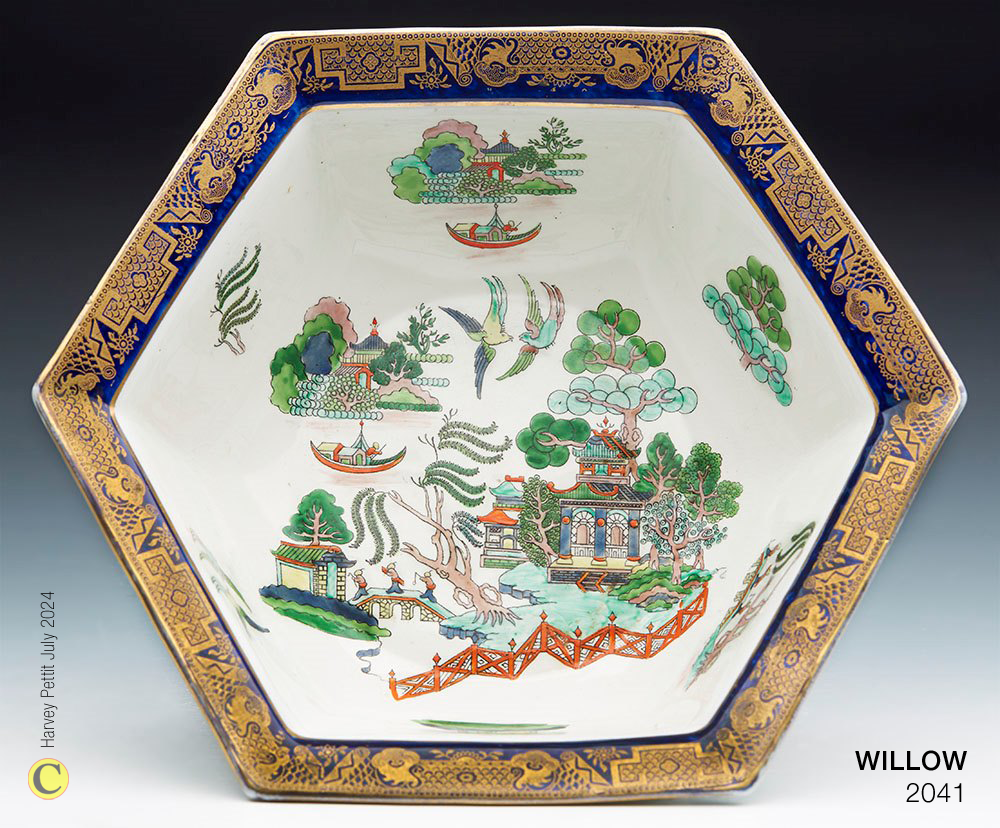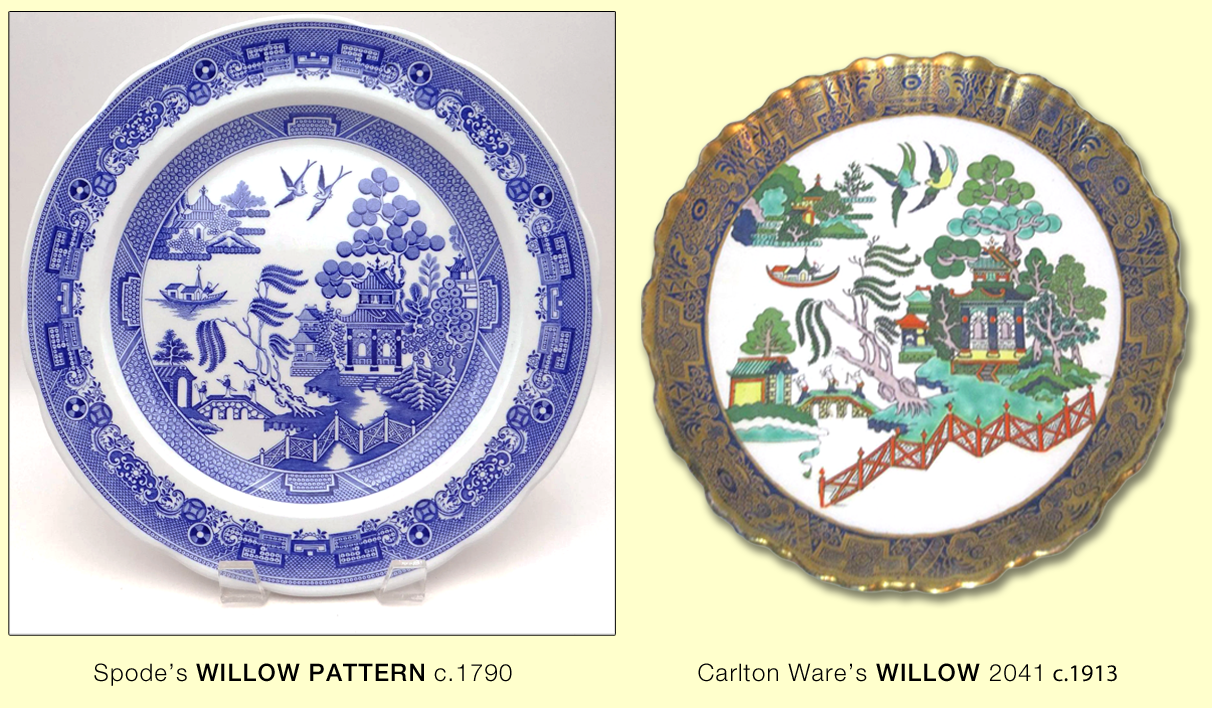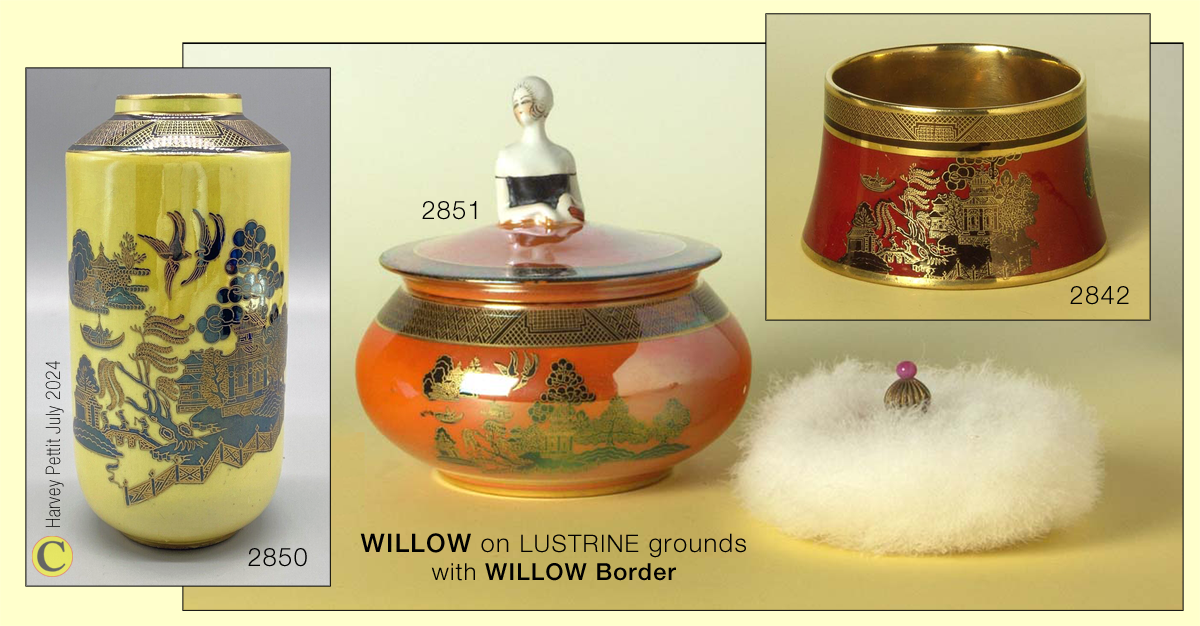
WILLOW
Carlton Ware's WILLOW pattern and its Borders
by Harvey Pettitwith border artwork by Barbara Anne Lee
What we know as the standard 'Willow Pattern', usually printed in cobalt blue on a white ground, is considered to have been devised for Spode in the late eighteenth century. It was a reinterpretation of earlier Chinese export porcelain Blue and White patterns, which were legion.
Books, articles and papers have been written about the 'Willow Pattern' alone. For more than 150 years it was a mainstay of many potteries and was produced in a multitude of variations. Some still produce this stalwart today.
The key elements of a generic 'Willow Pattern' are the weeping willow tree, figures on a bridge, a figure on a boat, two birds in flight and a pagoda.
Below is Carlton Ware's version decorating a hexagonal bowl and introduced by Horace Wain shortly after he joined the pottery around 1913.

Printed in black with gold printed Worcester Willow Border on a POWDER BLUE ground.
To return to this page use your back button.
Enter Spode
Wain's WILLOW is a close copy of Spode's earliest 'Willow Pattern' though the twenty-six-year-old designer adds his touch by doing it all in coloured enamels as you can see on the bowl above. Carlton Ware's version is decorated in the famille verte palette of colours where greens are dominant. This colour arrangement is associated with the Chinese Kang-Hsi period (1662-1722).
Below is a comparison of Spode's version from around 1790 and Horace Wain's close copy from around 1913, though on the hexagonal bowl above Wain does not use either Spode's inner or outer border. Instead he chooses to copy one used by Royal Worcester, as we will see!
 To see this image fit your device's screen and/or enlarge it click or tap on the plates.
To see this image fit your device's screen and/or enlarge it click or tap on the plates.To return to this page use your back button.
Borders used with Carlton Ware's WILLOW
Sometimes it is not easy to firmly establish which border was devised for a particular pattern and this is the case here. If the surviving records from Wain's early years at the Carlton Works are anything to go by, pattern record keeping was eratic and scant. This must have been partly because of the inevitable disruption caused by the acrimonious ending of the partnership between Fred Wiltshaw and the Robinsons (James Alcock and, in particular, his young go-getting son Harold Taylor), which begins in 1910 and is not resolved until 1911. The looming 1914-18 World War will not have helped and for the duration and aftermath the conflict was disruptive to the running of all Potteries - so many male pottery workers were called up to fight in the War, many to be maimed or killed. (Wain was in a key occupation which prevented him from being called up.)
Despite many missing pattern numbers in the pattern records from Wain's early years, through examples, I observe that two borders are associated with his WILLOW, which, over time, according to the pottery's scant records from this time, had fourteen variants.
WILLOW Border - Enter Spode again!
Below, Barb has cleverly redrawn the first border associated with Carlton Ware's WILLOW, namely WILLOW Border. On some early variants the pattern and border are printed in black and hand coloured as Barb illustrates.

© Barbara Anne Lee 2023.
This geometric border appears to be a close copy of Spode's inner border as used on their plate from 1790 shown previously and enlarged below. It, and similar, was used by many other potteries throughout the nineteenth century on various Oriental inspired Blue and White transfer printed patterns. Again it originates in China.

Below are two early examples of Carlton Ware's WILLOW Border employed firstly on a dressing table tray decorated with WILLOW 590, one of Wain's first patterns for CW, and secondly on a teapot with an early bought-in chromo-lithographic decoration for which Wain must also have been responsible. He had gained experience of this relatively new type of polychrome slide-on transfer decoration whilst working for his former employer. On these two early examples the border is printed in black, not gold, and is hand coloured.

Left: WILLOW 590 dressing table tray. Right: teapot with a slide-on chromo-lithograph of a flower; pattern number absent.
Enter Royal Worcester
Although Carlton Ware's WILLOW was a close copy of Spode's 'Willow Pattern' from 1790, the other border that Wain chooses to use with it is a direct copy of one used by another well-established pottery, namely Royal Worcester. The border was devised for a pattern named 'Worcester Willow' and is said to have been introduced around 1880. As a consequence it makes sense to call this border Worcester Willow Border.
Worcester Willow Border
Barb's fine rendition of Wain's Worcester Willow Border used with WILLOW is shown below.

© Barbara Anne Lee 2023.
Click or tap on the image above to see how this border looks on different grounds.
To return to this page use your back button
At Wain's hand, through his WILLOW concoction, the 18th century meets the 19th century in the 20th!
Wain's Worcester Willow Border was also used on another of his Chinoiserie patterns that we call Nankin, which was introduced not long after his WILLOW 2021. We feature this in another article in this series on Wain's Chinoiserie patterns for Carlton Ware.
WILLOW Border is mostly found on later variants of WILLOW that employ LUSTRINE grounds. These attractive lustre decorations were introduced some ten or so years later during Enoch Boulton's tenure as decorating manager and designer in the 1920s. Below are three examples. Notice that the pattern and border are painted in solid black and then gold printed producing a dramatic effect against their contrasting grounds. To see this image fit your device's screen and/or enlarge click or tap on it.
To see this image fit your device's screen and/or enlarge click or tap on it.
To return to this page use your back button.
Click or tap on it to see it used with other grounds.

© Barbara Anne Lee 2023.
Barb would like to thank Terry Corcoran, Betty Maxworth and Kerry Barber for supplying good quality images to help her replicate the borders above.
That's enough of WILLOW for the day. My head is spinning even if yours is not!
Harvey
V2. Revised July 2024
Select bibliography:
Spode's Willow Pattern and other designs after the Chinese by Robert Copeland, Studio Vista 1990, which helped me to grapple with the complex history and source of the pattern.
Ceramics and Pottery: The Enduring Appeal of the Willow Pattern Print by Nigel Jeffries. The Oxford Handbook of Industrial Archaeology 2022.